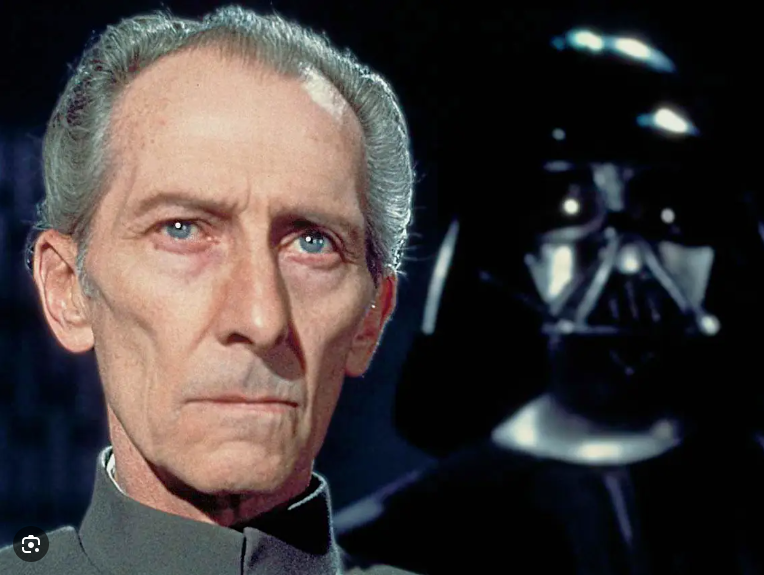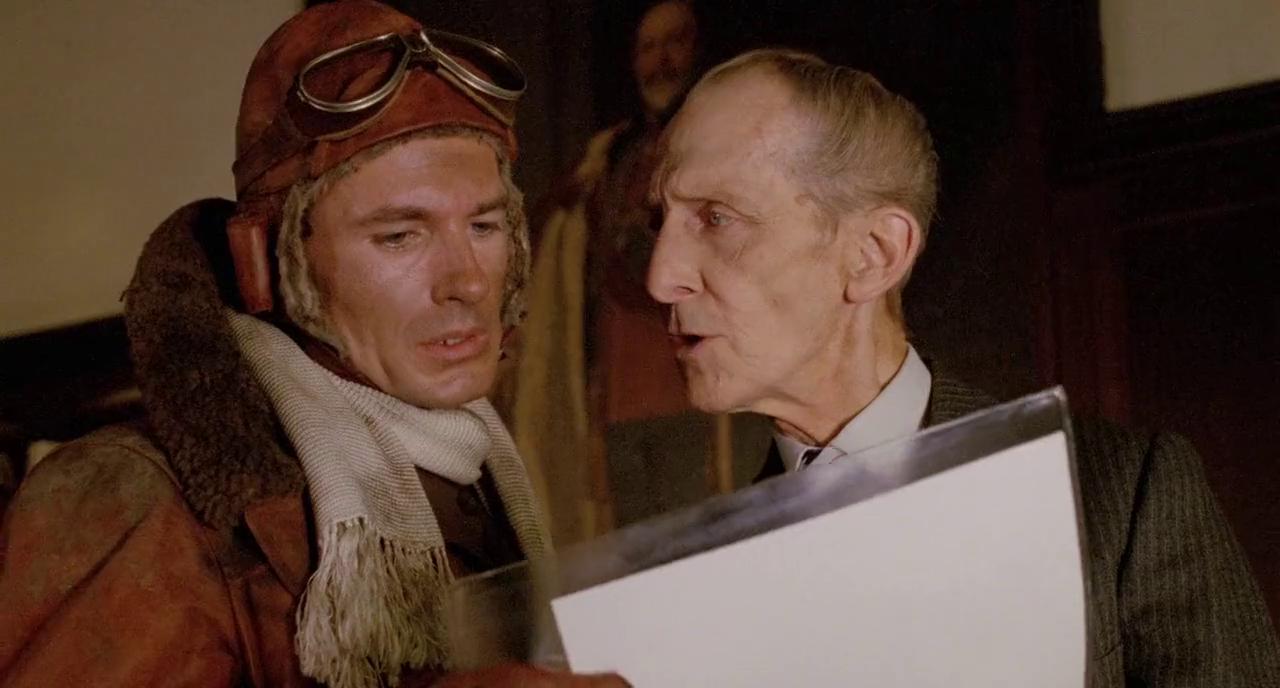REEL RETRO CINEMA: New looks at old flicks and their comics connections…

By ROB KELLY
Like many moviegoers my age, I was a huge fan of legendary actor Peter Cushing. My first memory of him was, of course, as Grand Moff Tarkin in Star Wars. I had no idea who this guy was, but his skeletal look and severe tone really sold me that this was nobody to mess around with. After all, he’s bossing around Darth Vader!
Thanks to Saturday and Sunday afternoon movies running on TV (and, later, video stores), it didn’t take long for me to discover Cushing’s other work, a lot of it horror and sci-fi, perfect fodder for my adolescent tastes. Horror of Dracula, The Curse of Frankenstein, At The Earth’s Core, Tales From The Crypt, Horror Express… the list went on and on.

Flash forward to the late ’90s, and the creation of IMDB. As I was wont to do, I was looking up the filmographies of some of my favorite actors and directors, overjoyed to have all this info at my fingertips. I remembered seeing Cushing in 1984’s Top Secret, and wondered, what did he do after that? IMDB told me his last film was 1986’s Biggles: Adventures in Time. I remembered thinking, “What the hell is a ‘Biggles’?” It sounded like a Saturday Morning cartoon about a family of oversized bears.
So, after choosing to cover the career of Peter Cushing for the latest episode of my film podcast, Fade Out, I set out to finally watch Biggles: Adventures in Time.

First off, I learned that Biggles is based on a long-running series of war/adventure novels by English author W.E. Johns that ran from 1932 all the way to 1968, totaling almost a hundred installments. They were massively popular young adult reading in England, but are relatively unknown in America—hence my complete bewilderment as to what a “Biggles” even was.
After the success of 1966’s The Blue Max, movie producers thought the time was right to bring Biggles to the big screen. They got so far as to hire actor James Fox and produce some promotional material, but the project fell apart, leaving Biggles in “development Hell” for over a decade, with actors like Dudley Moore, Oliver Reed, and Jeremy Irons coming and going.
Finally, in 1984, director James Hough (The Legend of Hell House, Dirty Mary, Crazy Larry, Escape To Witch Mountain) was hired, tapping actor Neil Dickson to play the title role, Alex Hyde-White as Jim Ferguson, and the legendary Cushing as Air Commodore William Raymond, who guides Ferguson (and the audience) as he travels back and forth through time.

In Biggles: Adventures in Time, hapless businessman Jim Ferguson finds himself involuntarily traveling back to 1917, where he saves the life of pilot James “Biggles” Bigglesworth. Before he can even understand what is happening, he returns to his own time. It’s then he meets the now elderly, but still kinda creepy, Raymond, who served with Biggles in WWI. Raymond explains to Ferguson that he and Biggles are “time twins” who get pulled through the time stream when one of them is in danger of losing their life. The film then hops back and forth across the time stream as Ferguson and Biggles try to stop the Germans from developing a “sonic weapon” that could win the war and change history forever.
Not having read any of the Biggles books, the biggest shock I learned about the film was the books do not feature Jim Ferguson—an American—or feature any sort of time travel, sci-fi stuff at all. They are relatively straightforward adventure stories, and the producers added the other elements to make the film presumably more marketable. I can’t imagine what a fan of the books’ reaction might have been, seeing this, uh, pretty drastic change.

The film has big ambitions, wanting to tell a big story full of grand adventure and amazing set pieces, but unfortunately Biggles just doesn’t have the budget to pull all this off. The stunt work is quite good, and the actors are in there pitching, with the WWI-era scenes being particularly effective, but the time travel effects look really chintzy and induce laughter rather than awe.
Not that bigger budget = better movie (often, it’s the reverse), but if you’re going to shoehorn a sci-fi element into your earthbound adventure story, it’s essential to have the resources to pull it off. Poor Alex Hyde-White, he of the Roger Corman Fantastic Four movie, always seemed to get stuck in projects where the producers’ reach exceeded their grasp.
It’s also unfortunate that the scenes with Ferguson at his job, dealing with his co-workers, are so flat and lifeless. At the very least, it’s fun seeing genre icon William Hootkins (Star Wars, Raiders, Batman) show up for a few minutes. The film tries to get a few chuckles out of Ferguson’s embarrassment by constantly being returned to his own time at the most inopportune moments.
But in a film called Biggles, why are we wasting time with this other guy? The character was obviously compelling enough to be the lead of several dozen popular novels, but he gets sidelined in his own movie.

Neil Dickson and Cushing
While he doesn’t get a whole lot to do, it is great fun seeing Peter Cushing, dressed all in black, pop in from time to time to get Ferguson up to speed. With that wonderfully sepulchral voice, he grounds all his scenes with import and menace, as absurd as this all might be.
There was somewhat of a marketing push for Biggles, including a newspaper strip that ran for five installments in May 1986, drawn by 2000 AD artist Arthur Ranson. The strip doesn’t tell a complete story, but rather ends on a cliffhanger, presumably with the hope that it will inspire audiences to go see the movie. Like a lot of comic book adaptations of movies, it drops all the character stuff in favor of the action beats, and I thought it was a pretty solid read (plus I love Ranson’s spot-on rendering of Cushing).

Biggles: Adventures in Time had its premiere in front of Prince Charles and Princess Diana, no less, but no word of what either thought of it. It is safe to say they liked it more than Superman IV: The Quest For Peace, which they were subjected to a year later.
Peter Cushing would live for almost another decade, and in his autobiography, he briefly mentions working on Biggles, clearly comfortable letting it stand as his final film. It’s not a great movie by any means, but it’s not without merit and Cushing gets to look cool and is clearly having fun. If you’re a fan of his, and you’ve already seen a lot of his other films, it’s worth a viewing.
—
MORE
— 1980’s FLASH GORDON: Movie of the (Wonderfully) Impossible! Click here.
— THE SLOW AND THE FURIOUS: Dig This INSIDE LOOK at 1974’s KILLDOZER. Click here.
—
ROB KELLY is a podcaster, writer, and film historian. He is the host of various podcasts on The Fire and Water Podcast Network, including Fade Out, Pod Dylan, TreasuryCast, and M*A*S*HCast. The new episode of FadeOut features Peter Cushing. Click here to listen or check it out wherever you find your podcasts.
